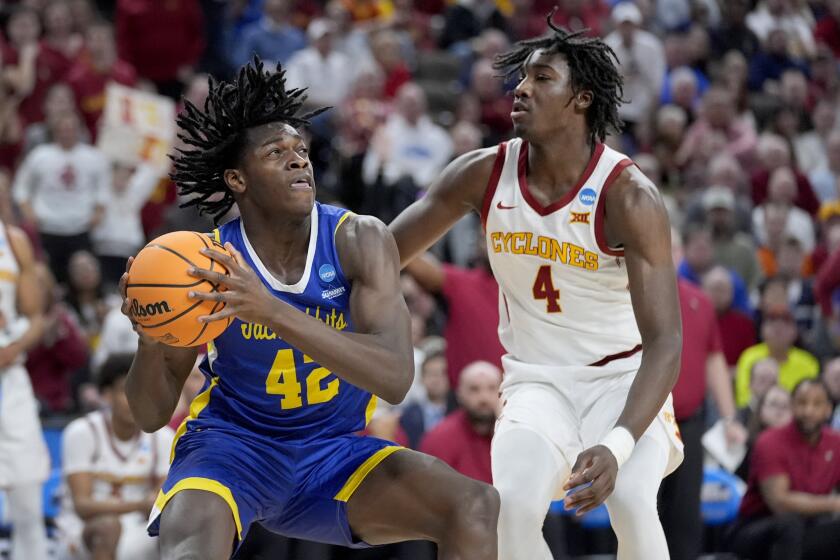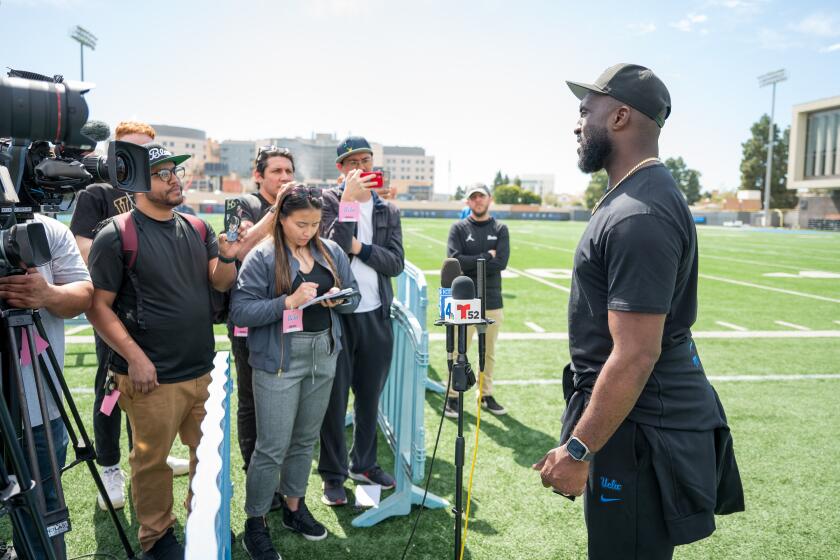Test Pattern
Junior Taylor remembers the play well: a basic reverse, on which he took the ball running to his right, then cut sharply to his left as the defense was shifting.
He split two defenders and dashed 49 yards to the end zone. The touchdown gave UCLA a 7-0 lead and the Bruins defeated Colorado State, 30-19. It was the 2002 season opener and Taylor’s first carry.
But the play remains fresh in his mind for another reason: It was a moment he thought might never come.
Taylor was supposed to be a freshman in 2001, but he scored poorly on his college entrance exam and was told to go home and wait another year.
“For a good two weeks, I was just drowning in my own sorrow,” he recalls. “I didn’t move and didn’t say much, until one day my sister told me I had to step up to the plate and move forward.”
It was the push he needed. Taylor, who got a qualifying score on the exam on his second try, went into the 2002 season determined to excel on and off the field.
Now, as the Bruins prepare for Thursday’s Las Vegas Bowl against Wyoming, the 6-foot-1, 207-pound junior leads the team in receptions with 31, including an 83-yard touchdown catch in a key game against Oregon, and a 39-yard catch to sustain a late scoring drive against USC.
His emergence from the shadows of seniors Craig Bragg and Tab Perry couldn’t be more timely, what with their imminent departure. “I think he understands that he’s in a leadership role now,” Coach Karl Dorrell says. “He’s had some big plays in the past couple of games and we’re hoping that can continue to be a trend.... “
Another trend is occurring in the classroom.
“I’m working on a streak of three straight quarters on the honor roll,” Taylor says with a smile.
*
When Taylor struck early in his debut against the Rams, it seemed like old times. The fleet receiver was a threat to score every time he had the ball at Mesa High in Arizona.
As a senior he caught seven touchdown passes for the Jackrabbits, scored three times on punt returns and twice on kickoff returns.
“The first two or three times he would go for eight or nine yards, but every third or fourth time he would go for 80,” recalls Gary Butler, then the offensive coordinator for Mesa.
Those were the days. Taylor and his older brother De, now a defensive back at Western New Mexico, were football stars and among the memories they share is the time Junior blocked a punt and De ran it back for a touchdown.
What was so remarkable, Junior says, was that they had predicted it only hours earlier, on a video game.
The touchdown he scored on his first carry as a freshman was one of two he scored during his freshman season, when he appeared in all 13 games but had only 14 receptions for 167 yards.
As a sophomore he had 24 catches for 302 yards, but most of the passes were on short routes and he scored only once. With an academically ineligible Perry sitting out the 2003 season -- he was reinstated this season -- Bragg and tight end Marcedes Lewis were quarterback Drew Olson’s primary big-play targets.
This season, Taylor had resigned himself to a similar role. The West Coast offense the Bruins employ is designed primarily for ball control. But as he asserted himself, he found that he was getting more attention, and making more catches at key moments.
At Washington, he had four receptions, including an 18-yarder on third down that helped the Bruins burn five minutes late in a game they won, 37-31. The 83-yard touchdown catch against Oregon stifled a roaring Eugene crowd and gave the Bruins a 31-20 lead in a victory that made them bowl eligible.
His 39-yard, fourth-quarter reception in the last game against USC -- a difficult, off-balance catch repeated on many highlight shows -- advanced the ball to the USC 12-yard line and four plays later the Bruins scored on a pass to Lewis, which cut the Trojans’ lead to what would become the final score, 29-24.
Now Olson, also a junior, fondly refers to Taylor as “the grandfather” of a young corps of receivers who will be counted on in 2005 and beyond.
“We always thought he had the capability to make the big plays,” Olson says. “We’ve seen it so many times in practice. It was just a matter of when it would start happening [regularly] in games.”
*
Looking forward, Taylor sees himself first as an NFL player and then as a law-enforcement specialist or businessman, though he’s still undecided. “My mind changes weekly,” he says.
Looking back, he says he regrets quitting basketball as a high school senior to focus on football. He loved track and field and was part of a 400-meter relay team that dominated its rivals.
Of his “embarrassing” performance in the SAT, required for admission to college, Taylor says it was especially painful because he graduated from high school with a B-plus average.
“This should be my senior year,” he says.
Instead, that’s just ahead and it’s not so bad, given the circumstances. Perhaps not, Taylor agrees, turning upbeat.
“I know my time is coming,” he says. “I’m going to cherish it, and I’m going to run with it.”
All the way to the end zone, if he can.
Go beyond the scoreboard
Get the latest on L.A.'s teams in the daily Sports Report newsletter.
You may occasionally receive promotional content from the Los Angeles Times.



